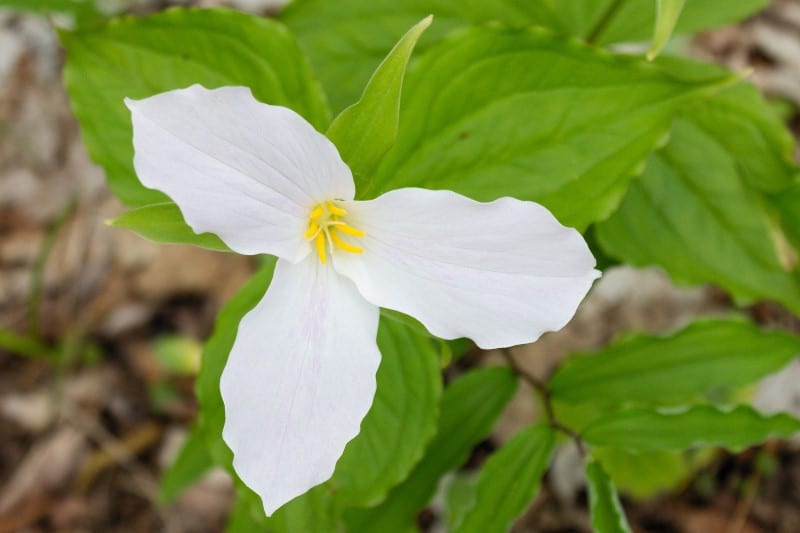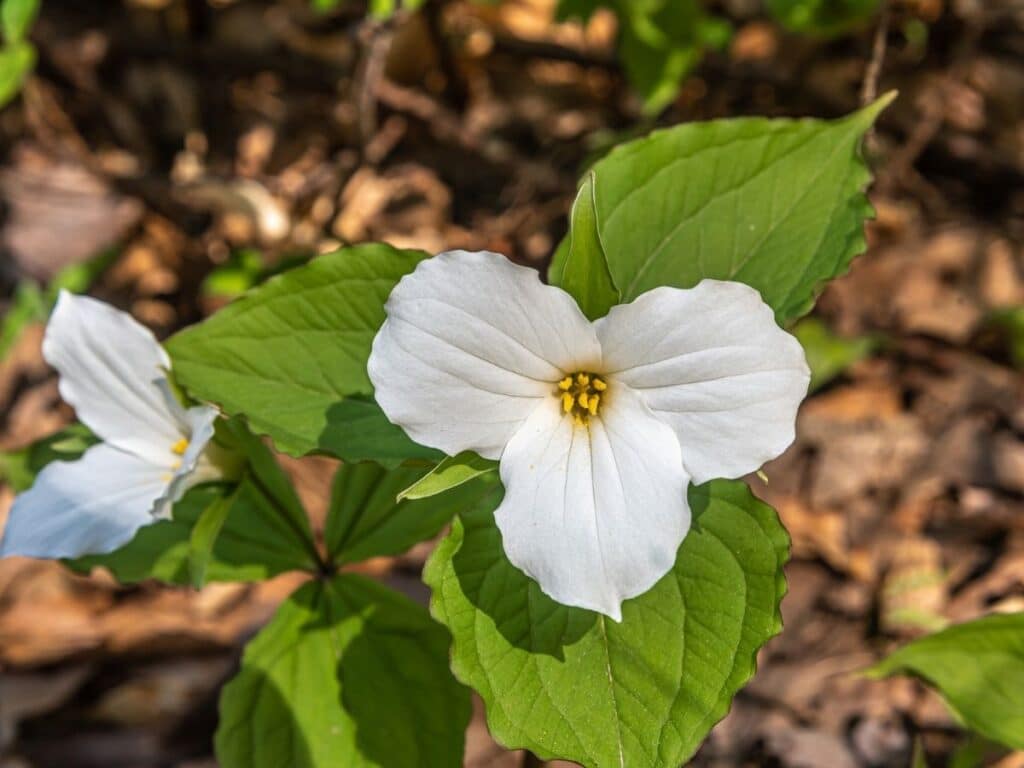Are you interested in learning how to plant, grow, and care for trillium flowers? If so, you’ve stumbled upon the ultimate resource to help you on your journey in learning how to care for these gorgeous flowers.
Trilliums (Trillium), are breathtaking flowers regardless of whether you behold them in their native woodland habitats or growing in the more cultivated garden. Native to North America and Asia, these spring-blooming plants are some to consider growing if you want showy flowers and unending beauty.
Here’s how to plant, grow, and care for the elegant, understated trillium flower in your own garden today.
What is Trillium?

You may hear trillium flowers referred to by a medley of other names, including wake robin and birthroots. This whimsical name is a testament to the plant’s flowering time, which typically coincides with the arrival of springtime robins.
The name trillium, however, is derived from the fact that everything about this plant comes in threes. It has three blooming characteristics (it can grow upright, dropping, or nodding), seed pods with three sections, three leaves, and a flower with three petals. Hence- trillium!
A herbaceous perennial, this trinity flower generally grows up to two feet tall and wide, though the exact size varies depending on the species. It prefers loamy, moist, and well-draining soil but can thrive in full or partial shade.
They tend to be low-maintenance as long as you select the right planting site. You’ll want to avoid planting them near shallowly-rooted shrubs and trees that might compete for moisture.
Growing Trillium Flower

Trilliums bloom early in the spring, becoming dormant by the middle of the summer. However, in some cases, you may be able to perfect the growing environment so that these plants bloom long into the late summer months.
Before planting your flowers, it is important that you do your best to provide conditions that are similar to the flower’s native habitat. Think moist, well drained soil amended with lots of organic matter.
These native plants can grow in partial shade and are, in fact, perfect for wooded wildflower gardens or even complete shade gardens.
They grow wonderfully alongside similar woodland plants like jack-in-the-pulpit, ferns, toad lilies, and crested irises. You can combine them with ferns and other spring-blooming wildflowers or plant them in colonies. Wherever you decide to plant, you may want to mark the rhizomes so that you don’t accidentally damage or dig them up when they are dormant.
As for temperatures, trilliums prefer temperate conditions, as you might be able to infer by looking at their native range. Each species and cultivar varies in terms of how much heat and cold they can handle (and what extremes) but humidity isn’t generally an issue one way or the other.
How to Plant Trillium
Some gardeners assume that they can just pluck trillium plants from their wild woodland habitats and transplant them into the garden. This is actually not a great idea.
That’s because trilliums do not transplant well and not all woodland varieties are suitable for the garden. Many are even endangered.
As a result, you should only buy transplants or seeds from a reputable nursery that specializes in these flowers. You can propagate them from seed yourself, too, although it can take up to five years to see any flowers at all.
If you want to start your own trilliums from seeds that you collect from wild plants, timing will be everything. Do so in late June or early July, ideally when the seedpod has changed from white to brown. You can sow the seeds immediately or, if you want to wait to plant, just store them in a bit of damp peat moss. Keep them cool (you can stick them in the fridge if you’d like) until you can plant them in a shady spot outside.
It doesn’t matter what time of the year you sow the seeds – they will germinate the following year.
Another option for planting trilliums is to take rhizome cuttings or divisions. This should be done in the late winter or fall, when the plant is still dormant and not putting on new growth.
Plant your cutting about two inches deep, cover it with soil, and be sure to space each plant about ten inches apart.

Caring for Trillium Plant
The good news about growing trillium flowers is that, once they are established, they require very little care. You just need to keep the soil evenly moist (though not soggy).
Watering
As mentioned earlier, these plants do best in partial to full shade. In fact, too much sunlight can scorch theft foliage and kill your plants, so it’s important to keep them mostly shaded, especially in hot environments.
Keep the soil lightly moist at all times but don’t overwater. Allowing your plants to sit in soggy soil for a long period of time can lead to root rot and other diseases that have the potential to kill your flowers.
For the most part, you shouldn’t need to provide supplemental watering – your flowers should get everything they need from rainfall alone. However, you may need to irrigate during particularly hot or dry weather to prevent the flowers from wilting.
Weeding
Don’t let other plants crowd your trilliums. That’s important regardless of whether the other plants are weeds or ones you have planted. These plants are quite sensitive to being overcrowded.
Fertilizing
Trilliums should be grown in soil that is neutral to slightly acidic. It should be rich in organic matter and good at holding moisture.
Choosing the right planting site is ideal and often eliminates the need for any fertilizing. However, if you find that you need to fertilize later on in the growing season, you can choose to do so.
The only time you should ever really need to fertilize these plants is if you are growing them in nutrient-poor soil. You can mix a bit of compost into the soil when you plant or add a fresh layer, topdressing, or compost tea each year. This should ideally be done in the spring.
Adding other organic fertilizers and amendments like composted leaves or leaf mulch can also be helpful. This will mimic the conditions the flowers would grow in naturally in the forest, helping your cultivated plants grow strong and healthy, too.
Pests and Diseases
One of the best things about growing trilliums is that they have strong resistance to most diseases and pests. You might see deer munching on them every now and then, but other than that, you shouldn’t have any issue growing these delicate flowers.
Other Tips for Growing Trillium Plants
One final note on growing trillium flowers is that they can be toxic. Though some forms of wildlife (and even people) eat the leaves, both the berries and roots can be toxic. You’ll know that a pet has munched on your flowers if they begin to exhibit symptoms like diarrhea, vomiting, nausea, and stomach pain.
Toxicity isn’t usually fatal or overly dangerous but it does depend on how much of the flowers are actually consumed. Therefore, it’s a good idea to plant your flowers in a spot where pets, livestock, and children won’t be able to reach them.
Common Types of Trillium
There are more than 40 trillium species growing in formal gardens as well as in the wild. While you can grow any type of trillium in your shade garden, there are a few that are more popular for gardens.
It’s Important that you do your research before planting any kind of trillium, though. Some are listed as endangered in certain states but not others. Most varieties and cultivars are hardy in zones 4-9 and can be found in colors such as yellow, white, red, pink, green, and purple.
White Trillium (T. grandiflorum)
The most popular type of trillium, white trillium, has white flowers that appear to be nodding off to sleep resting atop dark green, wavy-looking leaves. The white flowers turn pink as the season wears on.
Yellow Trillium (T. luteum)
Yellow trillium has bronze-green or upright gold flowers that appear on solid green leaves.
It also has a scent that is reminiscent of fresh citrus, making it appealing both for its visual and aromatic appeal in the garden.
Red or Purple Trillium (T. erectum)
This plant can also be referred to as stinking Benjamin! Despite the unpleasant name, it actually has quite an attractive appearance, with bright purple flowers.
The bad news about this type of the plant is that it has a less-than-pleasant aroma – many gardeners describe it as being quite like rotting meat.
Toadshade Trillium (T. sessile)
This kind of plant has red or purple flowers surrounded by green mottled leaves.
Prairie Trillium (T. recurvatum)
This type of trillium is easily recognized with dark maroon blooms that set down on the main stalk. Growing up to 18 inches tall, this is one of the largest cultivars you will find.
FAQs
Can trilliums be potted?
Yes, trilliums can be potted, but they prefer undisturbed soil conditions. So, it’s best to buy them from a nursery rather than digging them up yourself.
How long do trilliums live for?
Trilliums are long-lived plants. They can survive for decades with proper care!
Can trilliums be moved?
No, moving trilliums is risky because they have sensitive root systems. It’s best to leave them where they are unless absolutely necessary.
How rare are trilliums?
Trilliums aren’t super rare, but some species are uncommon. They’re most diverse in the southern Appalachian Mountains.
What is the life cycle of a trillium?
Trilliums emerge in early spring, flower, then die down in summer. They spend the rest of the year underground storing energy in their rhizomes.
Final thoughts
Trilliums are beautiful flowers that can be grown in many different types of soil and climates.
However, there are some steps to take before you plant your seeds or seedlings so that they have the best chances of survival. These tips will help your trillium grow into a full-grown plant with vibrant blooms!
Up next: Trillium Flower Meaning and Symbolism
References
References:
University of Arkansas: Plant of the Week: Trillium, Red
Cornell University: Trillium
North Carolina State University Extension: Trillium
Close
*image by PavelS/depositphotos






